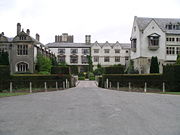
Coombe Abbey
Encyclopedia


Coventry
Coventry is a city and metropolitan borough in the county of West Midlands in England. Coventry is the 9th largest city in England and the 11th largest in the United Kingdom. It is also the second largest city in the English Midlands, after Birmingham, with a population of 300,848, although...
and Brinklow
Brinklow
Brinklow is a village and parish in the Rugby district of Warwickshire, England. It is about halfway between Rugby and Coventry, and has a population of 1,041 ....
in the countryside of Warwickshire
Warwickshire
Warwickshire is a landlocked non-metropolitan county in the West Midlands region of England. The county town is Warwick, although the largest town is Nuneaton. The county is famous for being the birthplace of William Shakespeare...
, England
England
England is a country that is part of the United Kingdom. It shares land borders with Scotland to the north and Wales to the west; the Irish Sea is to the north west, the Celtic Sea to the south west, with the North Sea to the east and the English Channel to the south separating it from continental...
. The house's original grounds are now a country park
Country park
A country park is an area designated for people to visit and enjoy recreation in a countryside environment.-History:In the United Kingdom the term 'Country Park' has a special meaning. There are over 400 Country Parks in England alone . Most Country Parks were designated in the 1970s, under the...
known as Coombe Country Park
Coombe Country Park
Coombe Country Park is a country park located in Warwickshire, England. Although the park is geographically in Warwickshire, it is only a few miles to the east of Coventry and is managed by Coventry City Council. The park has been developed from the grounds of an old abbey, the buildings of which...
and run by Coventry City Council.
History
Coombe Abbey was founded as a monasteryMonastery
Monastery denotes the building, or complex of buildings, that houses a room reserved for prayer as well as the domestic quarters and workplace of monastics, whether monks or nuns, and whether living in community or alone .Monasteries may vary greatly in size – a small dwelling accommodating only...
in the 12th century. Following the Dissolution of the Monasteries
Dissolution of the Monasteries
The Dissolution of the Monasteries, sometimes referred to as the Suppression of the Monasteries, was the set of administrative and legal processes between 1536 and 1541 by which Henry VIII disbanded monasteries, priories, convents and friaries in England, Wales and Ireland; appropriated their...
in the 16th century it became royal property.
Elizabeth of Bohemia
Elizabeth of Bohemia
Elizabeth of Bohemia was the eldest daughter of King James VI and I, King of Scotland, England, Ireland, and Anne of Denmark. As the wife of Frederick V, Elector Palatine, she was Electress Palatine and briefly Queen of Bohemia...
, the daughter of king James I
James I of England
James VI and I was King of Scots as James VI from 24 July 1567 and King of England and Ireland as James I from the union of the English and Scottish crowns on 24 March 1603...
, was educated there in the early 17th century. Had the Gunpowder Plot
Gunpowder Plot
The Gunpowder Plot of 1605, in earlier centuries often called the Gunpowder Treason Plot or the Jesuit Treason, was a failed assassination attempt against King James I of England and VI of Scotland by a group of provincial English Catholics led by Robert Catesby.The plan was to blow up the House of...
succeeded she was to have been abducted from Coombe Abbey and proclaimed as Queen Elizabeth II.
In 1682, the West Wing was added by architect
Architect
An architect is a person trained in the planning, design and oversight of the construction of buildings. To practice architecture means to offer or render services in connection with the design and construction of a building, or group of buildings and the space within the site surrounding the...
Captain William Winde
William Winde
Captain William Winde was an English gentleman architect, whose Royalist military career, resulting in fortifications and topographical surveys but lack of preferment, and his later career, following the Glorious Revolution, as designer or simply "conductor" of the works of country houses, has...
, who also designed Buckingham House, which later became Buckingham Palace
Buckingham Palace
Buckingham Palace, in London, is the principal residence and office of the British monarch. Located in the City of Westminster, the palace is a setting for state occasions and royal hospitality...
. In 1771, Lancelot 'Capability' Brown
Capability Brown
Lancelot Brown , more commonly known as Capability Brown, was an English landscape architect. He is remembered as "the last of the great English eighteenth-century artists to be accorded his due", and "England's greatest gardener". He designed over 170 parks, many of which still endure...
redesigned the gardens, incorporating the Coombe Pool lake.
For successive generations Coombe Abbey was owned by the Earls of Craven, in whose possession the estate remained until 1923.
In November 1964 Coventry City Council bought Coombe Abbey with 150 acre (0.607029 km²) of land. The park was opened to the public in 1966.
TV and Film
Coombe Abbey was used as the outside of the Mayor's house in the 2009 film, Nativity!,starring Martin FreemanMartin Freeman
Martin John C. Freeman is an English actor. He is known for his roles as John in Love Actually, Tim Canterbury in the BBC's Golden Globe-winning comedy The Office, Arthur Dent in the film adaptation of Douglas Adams' The Hitchhiker's Guide to the Galaxy, Dr. John Watson in Sherlock and Mr. Madden...
External links
- Coombe Abbey hotel website
- Online edition of a 1961 book called The Story of Combe Abbey - includes updates and "then and now" photographs
- Information about the park from Coventry City Council

